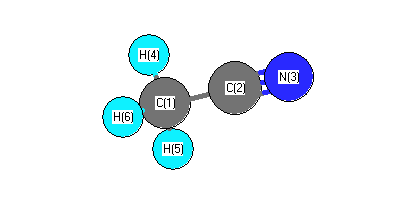Vibrational Frequencies calculated at HF/cc-pVTZ
| Mode Number |
Symmetry |
Frequency
(cm-1) |
Scaled Frequency
(cm-1) |
IR Intensities
(km mol-1) |
Raman Act
(Å4/u) |
Dep P |
Dep U |
|---|
| 1 |
A1 |
3195 |
2908 |
4.73 |
159.31 |
0.00 |
0.00 |
| 2 |
A1 |
2595 |
2361 |
16.00 |
53.24 |
0.20 |
0.33 |
| 3 |
A1 |
1535 |
1397 |
0.21 |
2.88 |
0.54 |
0.70 |
| 4 |
A1 |
960 |
874 |
6.13 |
4.90 |
0.11 |
0.20 |
| 5 |
E |
3270 |
2976 |
3.51 |
57.60 |
0.75 |
0.86 |
| 5 |
E |
3270 |
2976 |
3.51 |
57.60 |
0.75 |
0.86 |
| 6 |
E |
1593 |
1450 |
9.80 |
6.51 |
0.75 |
0.86 |
| 6 |
E |
1593 |
1450 |
9.80 |
6.51 |
0.75 |
0.86 |
| 7 |
E |
1159 |
1055 |
1.25 |
0.04 |
0.75 |
0.86 |
| 7 |
E |
1159 |
1055 |
1.25 |
0.04 |
0.75 |
0.86 |
| 8 |
E |
425 |
386 |
1.50 |
3.17 |
0.75 |
0.86 |
| 8 |
E |
425 |
386 |
1.50 |
3.17 |
0.75 |
0.86 |
Unscaled Zero Point Vibrational Energy (zpe) 10589.1 cm
-1
Scaled (by 0.9101) Zero Point Vibrational Energy (zpe) 9637.1 cm
-1
See section
III.C.1 List or set vibrational scaling factors
to change the scale factors used here.
See section
III.C.2
Calculate a vibrational scaling factor for a given set of molecules
to determine the least squares best scaling factor.
Charges, Dipole, Quadrupole and Polarizability
Charges from optimized geometry at HF/cc-pVTZ
Charges (e)
| Number |
Element |
Mulliken |
CHELPG |
AIM |
ESP |
| 1 |
C |
-0.245 |
|
|
|
| 2 |
C |
-0.080 |
|
|
|
| 3 |
N |
-0.074 |
|
|
|
| 4 |
H |
0.133 |
|
|
|
| 5 |
H |
0.133 |
|
|
|
| 6 |
H |
0.133 |
|
|
|
Electric dipole moments
Electric dipole components in Debye
(What's a Debye? See section
VII.A.3)
| |
x |
y |
z |
Total |
| |
0.000 |
0.000 |
-4.139 |
4.139 |
| CHELPG |
|
|
|
|
| AIM |
0.000 |
0.000 |
-2.698 |
2.698 |
| ESP |
0.002 |
0.000 |
4.165 |
4.165 |
Electric Quadrupole moment
Quadrupole components in D Å
| Primitive |
|---|
| | x | y | z |
|---|
| x |
-17.627 |
0.000 |
0.000 |
| y |
0.000 |
-17.627 |
0.000 |
| z |
0.000 |
0.000 |
-20.909 |
|
| Traceless |
|---|
| | x | y | z |
|---|
| x |
1.641 |
0.000 |
0.000 |
| y |
0.000 |
1.641 |
0.000 |
| z |
0.000 |
0.000 |
-3.282 |
|
| Polar |
|---|
| 3z2-r2 | -6.563 |
|---|
| x2-y2 | 0.000 |
|---|
| xy | 0.000 |
|---|
| xz | 0.000 |
|---|
| yz | 0.000 |
|---|
|
Polarizabilities
Components of the polarizability tensor.
Units are
Å
3 (Angstrom cubed)
Change units.
| |
x |
y |
z |
| x |
3.025 |
0.000 |
0.000 |
| y |
0.000 |
3.025 |
0.000 |
| z |
0.000 |
0.000 |
5.142 |
<r2> (average value of r
2) Å
2
| <r2> |
44.722 |
| (<r2>)1/2 |
6.687 |
